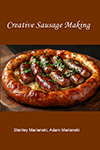Meats and Sausages
Mazovia Head Cheese (Salceson Mazowiecki)
| Meats | Metric | US |
|---|---|---|
| Skwarki* | 300 g | 0.66 lb |
| Pork skins | 150 g | 5.29 oz |
| Pork jowls | 150 g | 5.29 oz |
| Hearts, kidneys, head meat** | 250 g | 0.61 lb |
| Blood | 150 g | 5.29 oz |
Ingredients per 1000g (1 kg) of meat
| salt | 12 g | 2 tsp |
| marjoram | 1.5 g | 3/4 tsp |
| herbal pepper*** | 1.5 g | 3/4 tsp |
| allspice | 0.5 g | 1/2 tsp |
| onion | 5 g | 2 tsp |
Instructions
- Rinse meats in cold running water.
- Except spleen, brains and blood and skwarki (* see note), poach other meats in small amount of water:
- lungs, kidneys, veal heads, veal casings and pork trimmings at 85°C (185°F) for about 90 min
- beef trimmings, skins, heads, tripe, and udders at 95 C (203°F) for about 2 hrs until semi-soft.
- jowls at 85°C (185°F) until semi-soft.
- After poaching remove gristle from lungs and meat from heads. Spread meats apart on a flat surface to cool. Soak skwarki (* see note) in stock (remaining after boiling meats) taking 40 liters of stock for 100 kg of skwarki (* see note).
- Cut jowls into 8-10 mm (3/8”) cubes. Meats, spleen, kidneys, udders, tripe, sheep casings and veal head meat ground through 5 mm plate. Skwarki (* see note) and skins ground through 3 mm plate.
- Mix all meats with salt, spices and blood together.
- Stuffing materials: beef or veal bungs, middles, 60-100 mm synthetic casings. Butcher’s twine. Stuff casings loosely and tie the ends with twine.
- Poach head cheeses at 85°C (185°F) for 90-120 min (depending on size) until the internal temperature of the meat reaches 68-70°C (154-158°F). Remove air with a needle from pieces that swim up to the surface.
- Spread head cheeses on a flat surface at 2-6°C (35-43°F) and let the steam out. Then flatten them with weight and cool them to below 6°C° (43°F). If there is no proper cooler available, cool them down to less than 12°C (53°F)
- After cooling clean head cheeses of any fat and aspic that accumulated on the surface, even them out and cut off excess twine.
Notes
* Skwarki are light brown fried pork cubes that look like fried bacon bits. Dice pork back fat or fat pork trimmings into ¼ cubes and fry in pan using slow heat until becoming light brown. Skwarki is the byproduct of making lard by fat rendering. Fatback is the preferred choice and skwarki with lard have been used as butter in Europe for centuries.
**Meat trimmings of all kind: hearts, kidneys. pork and head meat, lungs, veal casings, beef tripe, udders, spleen, low grade pork and beef trimmings. Some of these meats will be hard to obtain in metropolitan areas, however, you can substitute them with meats which are rich in connective tissue such as pork legs or jowls. They contain collagen which is needed to produce the natural gelatin.
***Herbal pepper (white mustard seed, caraway, marjoram, chili, hot and sweet paprika, bay leaf). Herbal pepper can be substituted with an equal amount of black pepper.
Finished product : length 15-30 cm (6-12”), diameter 6-12 cm (2-5”)


















